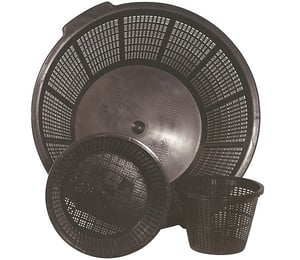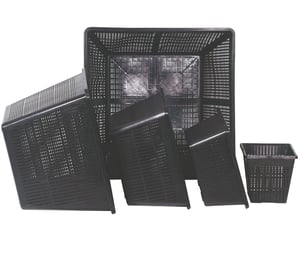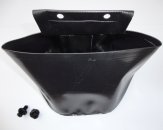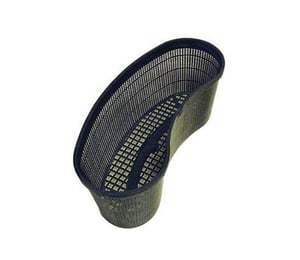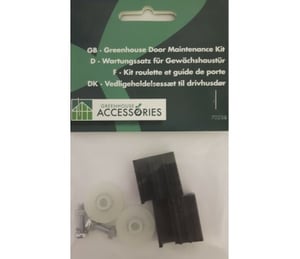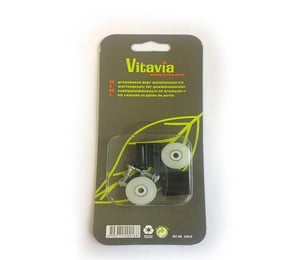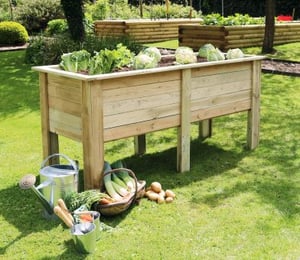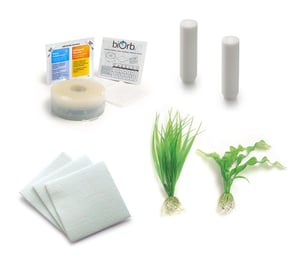What To Do In The Garden In May
With spring encouraging everyone out into the garden and the threat of frost disappearing during May, David Coton is in no doubt that May is going to be one of the busiest months of the year.
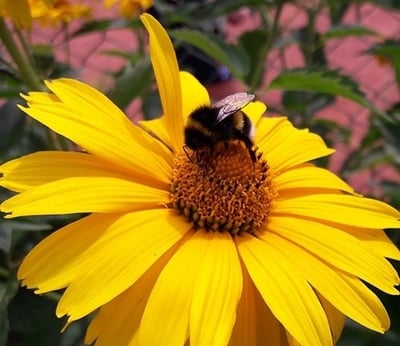
With spring encouraging everyone out into the garden and the threat of frost disappearing during May, David Coton is in no doubt that May is going to be one of the busiest months of the year.

May is the month when hanging baskets arrive in our Garden Centre, perfect if you want fabulous colour decorating your house and garden throughout the summer.
If you are making up your own basket don't forget to include water retaining crystals and slow release fertilizer. Baskets need to be watered daily, perhaps twice a day in hot weather, and dead heading will ensure the colour keeps on coming.
Many plants that have been over-wintering in the greenhouse can now steadily emerge. For example, cannas can be placed in a sheltered position so they get used to temperature variations. Cover with fleece if frost is predicted.
Move over-wintering citrus plants from the greenhouse and put the pots on blocks to ensure good drainage. Prune to open up the centre. Scrape off the top inch of compost and replace with fresh. Drench with water with added seaweed, then water generously every week.
Start hardening off summer bedding and all your half-hardy plants in a cold frame or by placing them outside for an increasing amount of time during the day.
If you are buying new plants from the garden centre, remember to soak them in a bucket of water before planting. After rain it's a good idea to lay a mulch around them to conserve moisture.
Pot on cuttings when their roots reach the bottom of their pot, use fresh compost and they'll be ready to plant out in about six weeks.
Plant out sweet peas in a moisture retentive soil containing lots of organic matter, water in well. Tie to support sticks for the first four to six weeks then they will become self-supporting. Pinch out just above a pair of leaves to encourage a bushier plant.
To conserve their energy, remove seed heads from daffodils and tulips grown in pots but not the foliage.
If you need space that has been taken up by bulbs that have finished flowering, lift them without damaging the foliage and place them in a shallow trench. Cover the bulbs with earth and wait until the foliage has died down before lifting, cleaning and storing.
You can also lift and divide primroses when they have finished flowering, just tease them apart, then replant and water.
Remove any suckers from shrubs and fruit trees to just below ground level and use a thick mulch to discourage them.
Keep hoeing, hand picking and digging up weeds before they set seed, making sure the roots of perennial weeds are completely removed.
Prune spring-flowering shrubs such as viburnums, lilacs and forsythias once their blooms have faded. This ensures their shape is maintained, new strong growth is encouraged and weak, old and unproductive stems are cut out.
During dry periods, remember to keep young trees well watered. Keep weeds away from newly planted trees (about 3ft), they will grow much faster with the extra moisture.
Feed container plants which should now be growing strongly but have limited access to nutrients and moisture, a weekly dose of tomato food or liquid seaweed will be appreciated through to the autumn.
Take softwood cuttings from new growth and put straight into polythene bag. Cut just below a leaf node, place in free draining compost containing lots of perlite, water, then place in a propagator or cover with a polythene bag.
If you are growing a greenhouse grapevine, allow only three leaves to develop after a fruiting truss before pinching out the tip. Reduce the number of plums on a tree when they are the size of a pea so they are fewer but bigger.
At the end of the month it’s useful, if you want to extend the flowering period of herbaceous perennials such as asters, campanulas, heleniums and phlox, to cut back the stems by two thirds.
Tomatoes grown in pots and grow bags will need plenty of water especially during hot weather and spraying with water will encourage pollination. Don't forget to pinch out side shoots and use a liquid tomato fertilizer as directed.
Sort out any herbs that have become woody over winter by cutting back to encourage new growth. Cut back rocket that is going to seed.
Begin to lower the blades on the lawn mower. This will keep the lawn neat and slice through annual weeds. If you want a pristine lawn, a regular regime of feeding and weed control should be adopted. Grass grows very quickly in May, it's full of nitrogen so use as a mulch around potatoes, squash and courgettes (not sweet corn).
As the month progresses, continue to sow successive rows of vegetables. If it's too cold for some crops such as French beans, pumpkins, squash and sweet corn, sow them inside to plant out when the weather is warmer.
Runner beans should be sown above a trench that has been filled with organic matter over the past few weeks. Put in place a double row of bamboo canes, 9ins apart with a 2ft gap between the rows. Alternatively grow up a wigwam of four or six poles tied together. Plant two seeds at the base of each cane at a depth of 2ins.
It’s already time to start thinking about Halloween and a job that might interest children is to sow pumpkin seeds on their side in a 3in pot about 1in deep and cover with cling film to help retain moisture and warmth. Place on a windowsill, pot on and finally plant out in a sunny fertile spot.
Thin out spinach, lettuce and any other seedlings that have been directly sown in the vegetable bed.
If you have tomato plants in pots, when they have used up all the nutrients in the compost, plant them in greenhouse beds. Your greenhouse soil should be replaced every three years to prevent a build up of viruses. Plant deeply (2 – 3ins) up the stem and 15ins apart, so that roots grow from the stem. Give them a good soak once a week during May.
Earth up potatoes when new shoots show through. This protects them from a late frost and also direct sunlight that will turn the tubers green. If there's a dry spell they will appreciate some water.
When sowing peas, put in place twiggy branches or netting to support the plants when they emerge.. Support broad beans with canes and string around the perimeter of the plot.
Cloche strawberries so they don't get hit by frost and then net them discourage birds now. Remove blossom from first year plants. Ensure that other fruit is well watered and thin out gooseberries to encourage larger fruit.
Growing herbs from seed is easy, sprinkle the seed over compost in a seed tray and cover with vermiculite. Place in a water bath to absorb moisture and after about 20 mins put somewhere warm to germinate.
To avoid carrot fly, sow later in the season, choose a resistant carrot variety or try companion planting with onions or garlic and sowing amongst other vegetables, covering with fleece or surrounding the plot with 2ft high barrier of polythene or similar material.
Plant out cabbages and prevent cabbage white butterflies from laying eggs by covering with netting. Deter cabbage root fly by fitting brassica collars that can be made with roofing felt or carpet underlay.
Remove excess raspberry canes before they become too congested.
Actively encourage birds into the garden with a regularly replenished bird bath but avoid trimming hedges as you may damage the habitat of nesting birds.
May is a good time to introduce new life into your pond, give it a spring clean and prepare for the summer.
Netting should have prevented autumn leaves from falling into your pond but if any debris or decaying plant matter has collected, it should now be removed with a net or a pond vacuum.
If you have a UV filter pump, the bulb needs to be changed each year as its effectiveness deteriorates over time. Left unchanged it will become ineffective at eradicating suspended algae (green water). All types of pond pump should also be cleaned out to maintain optimum performance.
As water temperature slowly increases fish will become more active. Feeding can be increased and the type of food changed from wheatgerm based products to more proteinous fish food.
This is an excellent time to introduce new plants into the pond using specialist planting and aquatic compost, this allows them to become established before the summer.
Sunlight increases the growth of algae in the pond so floating plants such as water hyacinth can be beneficial as they shade the water, think about deep water plants such as lilies or marginal primulas and marigolds to achieve a varied aquatic landscape.
Although you must be careful not to overstock your pond, add fresh fish by initially floating the bag in which they arrive in your pond for about half an hour. This will equalise the temperature and reduce the chances of the fish feeling any shock from a sudden change of temperature. Don't add too many at once and keep an eye on the fish as they adjust to a new environment.
Bear in mind that timings for various gardening and aquatic activities vary throughout the country, these are jobs we expect to undertake in the Midlands, but there are no hard and fast rules for everyone.
Shop Now £0.99
Shop Now £0.99
Shop Now £6.99
Shop Now £2.65
Shop Now £17.99
Shop Now £14.99
Shop Now £154.99
Shop Now £13.99




